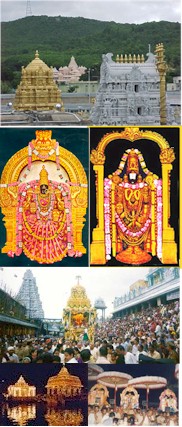Welcome to Adiyen Sri Ramanuja Dasan !
" Srimathe Ramanujaya Namaha !"
(88. Ans. Contd.) The Shankham is by far superior to the other components of the Lord’s arsenal, endowed with the power of making foes drop dead due to sheer fear, shock and trauma, occasioned by its benumbing boom—
“VishnO: mukhOttAnila pooritasya yasya dhvani: danava darpa hantA
tam PAnchajanyam sashi kOti shubhram Shankham sadAham sharaNam prapadyE”.
The Shankham does a clean job, with its victims just dropping dead, unlike the gory and bloody deaths caused by its peers like the Chakram and the Sword. As proof of the PAnchajanyam’s potency, we find that the moment Sri Krishna and Arjuna blew their conches in the battle field of Kurukshetra, the Kaurava army practically dropped dead with fear and shock, making Arjuna’s job of disposing them off much easier than it would have been otherwise. The following Gita slokas attest to this—
“MAdhava: PANdavaschaiva divyou Shankhou pradadhmatu:
PAnchajanyam HrisheekEsa: DEvadattam Dhananjaya:
“sa ghOshO DhArtarAshtrANAm hridayAni vyadArayat”
89. Q .: swamy you have explained us about the 4 zones, brahma, daiva, manushya and pichaca zones, but those are imaginary bifucation among the given plot of land, as far as i know their are 2 enclosures. one is wat v usually go around after the darshana, and see vimana venkateshwara and put the offerings. the other might go around thru the kalayana mantapa and come round thru the free prasadam exit side. Why is the layers important? i mean the 1st and the second prakarams, and many temples have 3 or 4.
Ans .: The first visible structures in most temples are the prakarams through which a devotee walks into the temple. These entryways consist of complex patterns of squares and rectangles. Depending on the size of a temple, there may be several prakarams with each smaller prakaram enclosed within a larger prakaram (e.g. Meenakshi Temple in Madurai). A devotee must walk through several of these prakarams before reaching the sanctum-sanctorum.
The prakarams may appear as simple entryways; but their design is actually a metaphor for the gunas (attributes) or stages of spiritual evolution that an individual goes through in life. Hindus believe that an individual consists of several gunas (such as tamasa, sativika, or rajasa); however, none of these gunas defines the individual entirely. To find one’s true self, an individual must discard each guna as a worldly affectation (Neti, Neti - I am not this; I am not this) until there are no more gunas to discard. When the individual reaches this stage, the individual will realise that the true self, i.e. God, is within oneself (Atman).
A square or a rectangular temple prakaram symbolises this concept of 'Neti' - the act of discarding and evolving as a physical form. After entering a temple, an individual goes through several prakarams before reaching the sanctum-sanctorum, the abode of God. The process of going through the prakarams to reach God symbolises the long path a human being takes before becoming one with the cosmic order. In a sense, a walk through the prakarams is not just a ritual, but rather a symbolic reflection of the process of learning; the act of discarding bondage and attachment and eventually discovering the true self.
Jai Srimannaryana !
Thanks for your valuable time. Visit our web site again for more information and latest updates.

